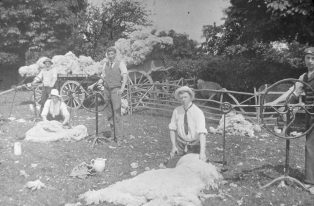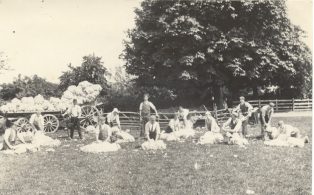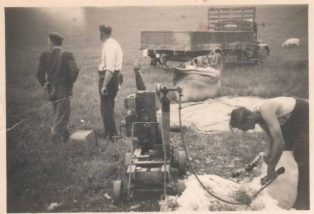Taking the fleeces to market
Judith Ellis
Harry Bennett’s recollections of the sales of fleeces
[After coming out of hospital in 1932] … I did an interesting 3 days work at the local wool auction, labelling bales of wool as they came in. The sale was held in the old tithe yard opposite the church. The tithe barn has now been demolished and a house built with the stone. The barn was in a very dilapidated state and almost roofless but it was all right for storing bales of wool in July. The actual auction was held in a marquee in the yard where the samples were on show, most of the buyers came from the Yorkshire woollen mills, after the sale we had to label all the bales with the buyer’s name and address and they 18 were despatched by rail. At that time we were renting the tithe yard and small buildings and stabling and a paddock for the horse and also storage for pig and poultry food.
The fleece sales (re)started in 1919, after WWI and in 1928 the Evesham Journal reported that there were 7000 fleeces sold. This number increased over the next ten years to 12,000 each year. No records of fleece sales after WWII have yet been found.
Another interesting account of the fleece market was published in the Daily News on Saturday 31st August 1929, written by Mabel New, wife of Oliver New, Campden solicitor.
A Cotswold Wool Sale
“It was the day of the annual Wool Sale at Chipping Campden; and, attracted by a crowd of motorcars outside the great Church Barn by the pool, I looked in through the wide open doors facing the road and found the sale in full swing. Now a Cotswold Wool Sale is not a thing of piles of hanks of yarn ready for the weaver, but mounds of fleeces fresh cut from the sheep, some washed, some unwashed, and all packed into huge ” sheets.” as they call the great bags in which the wool comes to the market, each ” sheet ” about the size of a full-sized feather bed. It was a scene to remember. The great L-shaped barn was piled high with the wool, bag upon bag, almost up to the roof round the walls, and on the soft lower slopes of this mountain of fleeces the buyers reclined comfortably, while a small space of floor was cleared for the auctioneer’s table, where he and his staff were at work.
The sheep paid for all
The sale takes place every year after sheep-shearing. and the buyers come from far and wide, the majority perhaps front Yorkshire and the Stroud Valley. There were 8,000 fleeces put up for sale that day: one local farmer had, I noticed, sent in nearly 300 himself. Sixteen different breeds of sheep were represented among those fleeces, From pure-bred Cotswolds to Shropshire, Southdown, Cheviot. Kerry and so on. The Cotswold towns owe much to their sheep, most of their beautiful buildings, as well as the pleasant pasture lands on the hills around them. In the windows of an old house at Holme, in Norfolk, built by a wool stapler, by name John Barton, is set the following couplet:
I thank God, and ever shall, It is the sheep that paid for all.
So It was In the Cotswolds, particularly in the beautiful little town of Chipping Campden. The sheep paid for its fine old houses and other buildings; for the men who bred the sheep and sold the wool spent their money generously on their town. These old woolstaplers had a fine public spirit, from which we are benefiting now. Far back in the fourteenth century, one, William Grevel, rebuilt a great part of the church, and probably also the fine old house in the High-street, with its beautiful oriel windows, where he lived, and which bears his name.”









No Comments
Add a comment about this page